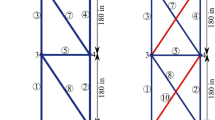Abstract
To design optimal mechanical structures, design sensitivity analysis technique using higher order derivatives are important. However, usual techniques for computing the derivatives, for example numerical differentiation methods, are hard to apply to real scale structures because of the large amount of computational time and the accumulation of computational errors.
To overcome the problem, we have studied a new approach for higher order sensitivity analysis of the finite element method using automatic differentiation techniques. The method automatically transforms FORTRAN code to special purpose code which computes both the value of the given functional dependence and their derivatives. The algorithm used in the method automatically and efficiently computes accurate values of higher order partial derivatives of a given functional dependence on many variables.
This paper reports the basic principles of the automatic differentiation method and some experiments on the sensitivity analysis of mechanical structures. The original program of structural analysis by the finite element method is implemented in FORTRAN, which is developed by the first author. Using the proposed method, we get more accurate sensitivity and prediction values compared with usual numerical differentiation. We also discuss the effectiveness of the proposed approach for the sensitivity analysis of the mechanical structures.
Similar content being viewed by others
References
Adelman, H. M.; Haftka, R. T. 1986: Sensitivity analysis discrete structural systems, AIAA. Journal, 24(5): 823–832
Belle, H. V. 1982: Higher Order Sensitivities in Structural Systems, AIAA. Journal, 20(2): 286–288
Berz, M. 1989: Differentiation algebraic description of beam dynamics to very high orders, Particle Accelerators, 24: 109–124
Berz, M. 1990a: Arbitrary order description of arbitrary particle optical systems, Nuclear Instruments and Methods in Physics Research A298: 426–440
Berz, M. 1990b: Computational Aspect of Optics Design and Simulation: COSY INFINITY, Nuclear Instruments and Methods in Physics Research A298, 473–479
Berz, M. 1991a: DAFOR-Differential Algebra Precompiler Version 3, MSCUCL-755, Michigan State University
Berz, M. 1991b: Forward Algorithms for High Orders and Many Variables, in: Automatic Differentiation of Algorithms: Theory, Implementation and Application, SIAM, Philadelphia
Berz, M. 1992: Automatic Differentiation as Nonarchimedean Analysis, in: Computer Arithmetic and Enclosure Methods, North Holland
Berz, M. 1994: Analysis on a Nonarchimedean Extension of the Real Numbers, Lecture Notes Studienstiftung Summer School, MSUCL-933, Michigan State University
Brebbia, C. A.; Hernandez, S. 1989, eds: Computer Aided Optimum Design of Structure, Springer-Verlag
Dailey, R. L. 1989: Eigenvector Derivatives with Repeated Eigenvalues, AIAA, Journal, 27(4): 486–491
Dixon, L. C. W. et al. 1988: Finite element optimization: The use of structured automatic differentiation, A. J. Osiadacz (ed.), Simulation and optimization of large systems, 117–141, Clarendon Press, Oxford
Eschenauer, H. et al. 1990, eds.: Multicriteria design optimization, Springer-Verlag
Evtushenko, Y. G. 1985: Numerical optimization techniques, Optimization Software, inc
Fox, R. L. et al. 1968: Rates of change of eigenvalues and eigenvectors, AIAA. Journal, 6(12): 2426–2429
Griewank, A.; Corliss, G. F. 1991, eds.: Automatic Differentiation of Algorithms-Theory, Implementation, and Application, SIAM, Philadelphia
Haftka, R. T. et al. 1986: Structure Shape Optimization-A Survey, Computer Methods in Applied Mechanics and Engineering, 57: 91–106
Haftka, R. T. et al. 1986: First- and second-order sensitivity analysis of linear and non-linear structures, AIAA. Journal, 24(7): 1187–1192
Haftka, R. T.; Adelman, H. M. 1989: Recent developments in structural sensitivity analysis, Structural Optimization 1: 137–151
Haug, E. J. et al. 1982: Second-Order Design Sensitivity Analysis of Mechanical System Dynamics, International Journal for numerical Methods in Engineering, 18: 1699–1717
Iri, M. 1984: Simultaneous computation of functions, partial derivatives and estimates of rounding errors-Complexity and practicality, Japan Journal of Applied Mathematics, 1, 2: 223–252
Iri, M.; Kubota, K. 1991: Norm, Rounding Errors, Partial Derivatives and Fast Automatic Differentiation, upieice transactions, vol. E74, No. 3: 463–471
Jawed, A. H.; Morris, A. J. 1984: A uppproximate higher-order sensitivities in structural design, Engineering Optimization, 7: 121–142
Jao, S. Y.; Arora, J. S. 1992: Design sensitivity analysis of non-linear structures using endochronic constitutive model, Computational Mechanics, 10: 39–57, Springer-Verlag
Kleiber, M. 1993: Shape and non-shape structural sensitivity analysis for problems with any material and kinematic non-linearity, Computer Methods in Applied Mechanics and Engineering, 108: 73–97
Kleiber, M.; Hisada, T. 1993, eds: Design Sensitivity Analysis, Atlanta Technology Publications
Ozaki, I. 1988: Mathematical method to design mechanical structures (Modal Analysis), (in Japanese) Computation and Analysis Seminar, No. 43, 15–24
Ozaki, I. 1989: Mechanical structures analysis using FEM by using the personal computer, (in Japanese), Computation and Analysis Seminar, No. 48: 14–21
Ozaki, I. 1991: Recent topics in integrated CAE (intelligent CAD, sensitivity analysis, mesh generation for the FEM), (in Japanese) Computation and Analysis Seminar, No. 58: 8–31
Ozaki, I.; Terano, T. 1992: Design Sensitivity Analysis Using an Automatic Differentiation Technique, S. N. Atluri et al. (eds), COMPUTATIONAL MECHANICS'92, Proceeding of the International Conference on Computational Engineering Science, 445, Springer-Verlag
Ozaki, I.; Kimura, F. 1994: A New Approach of Sensitivity Analysis for Optimal Mechanical Design, Third World Congress on Computational Mechanics Extend Abstracts, 1025–1026
Rall, L. B. 1986: The arithmetic of differentiation, Mathematics Magazine, 59(5): 275–282
Ratschek, H. et al. 1988: New Computer Methods for Global Optimization, John Wiley and Sons
Vanhonacker, P. 1980: Differential and Difference Sensitivities of Natural Frequencies and Mode Shape of Mechanical Structures, AIAA. Journal, 18(12): 1511–1514
Vanderplaats, G. N. 1984: Numerical Optimization Techniques for Engineering Design: with application, McGraw-Hill, Inc
Wanxie, Z. et al. 1986: Second-order sensitivity analysis of multimodel eigenvalues and related optimization techniques, J. Struct. Mech., 14(4): 421–436
Wu, C. C., Arora, J. S. 1986: Design Sensitivity Analysis and Optimization of Non-linear Structural Response Using Incremental Procedure, AIAA. Journal, 25(8): 1118–1125
Author information
Authors and Affiliations
Additional information
Communicated by S. N. Atluri, 29 March 1995
Rights and permissions
About this article
Cite this article
Ozaki, I., Kimura, F. & Berz, M. Higher-order sensitivity analysis of finite element method by automatic differentiation. Computational Mechanics 16, 223–234 (1995). https://doi.org/10.1007/BF00369867
Issue Date:
DOI: https://doi.org/10.1007/BF00369867




